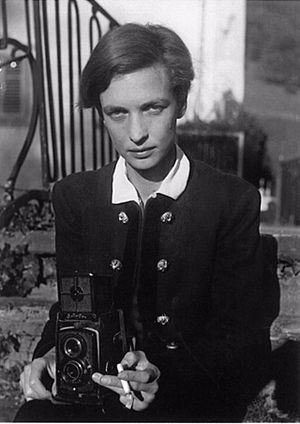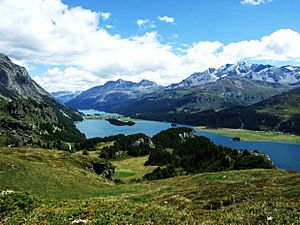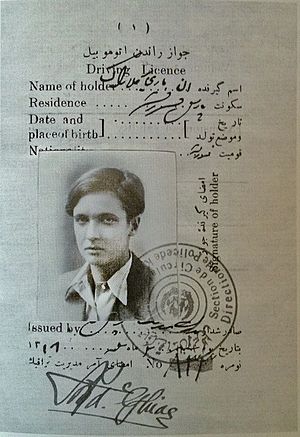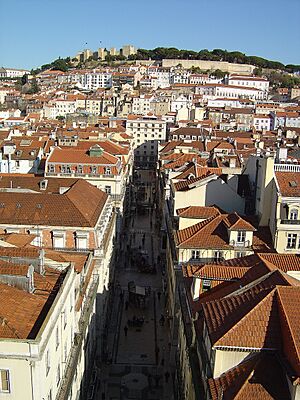Annemarie Schwarzenbach facts for kids
Quick facts for kids
Annemarie Schwarzenbach
|
|
|---|---|

Schwarzenbach (photo by Anita Forrer, 1938)
|
|
| Born |
Annemarie Minna Renée Schwarzenbach
23 May 1908 Zurich, Switzerland
|
| Died | 15 November 1942 (aged 34) |
| Resting place | Friedhof Horgen, Horgen, Switzerland |
| Nationality | Swiss, after 1935 French |
| Other names | Annemarie Clarac / Clark |
| Education | University of Zurich |
| Occupation | writer, journalist, photographer |
Annemarie Schwarzenbach (born May 23, 1908 – died November 15, 1942) was a talented writer, journalist, and photographer from Switzerland. She spoke out against unfair political ideas, like Fascism, which meant she had to live outside her home country for a while. During this time, she became good friends with the family of a famous writer named Thomas Mann.
Annemarie spent much of her life traveling and taking pictures for newspapers and magazines. In America, a young writer named Carson McCullers admired Annemarie very much. Carson even dedicated one of her books, Reflections in a Golden Eye, to her. Annemarie reported on the early parts of World War II. Sadly, she passed away after a fall caused a serious head injury.
Contents
Annemarie's Early Life
Annemarie Schwarzenbach was born in the city of Zurich, Switzerland. When she was four, her family moved to the Bocken Estate in Horgen, near Lake Zurich, where she grew up. Her father, Alfred, was a rich businessman in the silk industry. Her mother, Renée Schwarzenbach-Wille, was the daughter of a Swiss general. She was also a well-known host, an Olympic horse rider, and an amateur photographer.
From a young age, Annemarie preferred to dress and act in ways that were not typical for girls at the time. Her parents didn't mind, and she continued this style throughout her life. Sometimes, people even mistook her for a young man.
At her private school in Zurich, she mainly studied German, history, and music. She enjoyed dancing and playing the piano. But her biggest dream was to become a writer. She studied in Zurich and Paris. At 23, she earned her doctorate degree in history from the University of Zurich. She started writing while still a student. Soon after finishing her studies, she published her first short novel, Freunde um Bernhard (Bernhard's Circle). People liked it a lot.
Friendships and Travels
In 1930, Annemarie met Erika Mann and Klaus Mann, who were the children of the famous writer Thomas Mann. She was very impressed by Erika's charm and confidence. They became close, but their friendship didn't last long, which made Annemarie sad. However, they remained friends.
Still feeling a bit sad about Erika, Annemarie spent the next few years in Berlin, Germany. There, she found a close friend in Klaus Mann. She often visited the Mann family's home. She lived a fast-paced life in Berlin, which was a busy and artistic city during the end of the Weimar Republic.
Annemarie's way of life changed when the Nazis took power in 1933. The artistic scene in Berlin disappeared. Her family also had different political views. Some family members supported groups that wanted closer ties with Nazi Germany. Her parents wanted Annemarie to stop being friends with the Manns and help Germany under Adolf Hitler. But Annemarie was strongly against the Nazis. Her friends included Jewish people and political refugees from Germany. She refused to help the Nazis. Instead, she later helped Klaus Mann start an anti-Nazi magazine called Die Sammlung. This magazine helped writers who had to leave Germany by publishing their stories.
Annemarie took several trips abroad with Klaus Mann. They visited Italy, France, and Scandinavia in 1932 and 1933. Also in 1933, she traveled with photographer Marianne Breslauer to Spain. They went there to write a report about the Pyrenees mountains. Marianne was also very impressed by Annemarie. She wrote, "She was neither a man nor a woman, but an angel, an archangel." Marianne even took a famous photo of her. Later that year, Annemarie traveled to Persia (modern-day Iran). After returning to Switzerland, she went with Klaus Mann to a writers' meeting in Moscow, Russia.

In 1935, she went back to Persia. There, she married a French diplomat named Achille-Claude Clarac. They had known each other for only a few weeks. This marriage was helpful for both of them. Annemarie got a French diplomatic passport, which allowed her to travel freely. They lived together for a while in Tehran. Then they moved to a quiet area in the countryside to escape the summer heat.
Annemarie returned to Switzerland for a holiday, driving through Russia and the Balkans. She was interested in the story of Lorenz Saladin, a Swiss mountain climber and photographer. He had climbed some of the world's toughest peaks but had recently died near the Russian-Chinese border. Annemarie saw the quality of his photos in magazines. She also admired his brave attitude and confidence, which was different from her own struggles with sadness. In Moscow, she got Saladin's photos and diary. She took them to Switzerland, planning to write a book about him.
However, once home, she didn't want to go back to the lonely life she had in Persia. She rented a house in Sils in Switzerland. This house became a safe place for her and her friends. Here, she wrote her most successful book, Lorenz Saladin: Ein Leben für die Berge (A Life for the Mountains). She also wrote Tod in Persien (Death in Persia), which was published much later in 1998. A different version of this book, called Das glückliche Tal (The Happy Valley), came out in 1940.
Documenting the World
In 1937 and 1938, Annemarie used her photographs to show the rise of Fascism in Europe. She visited Austria and Czechoslovakia. She also took her first trip to the USA. There, she traveled by car with her American friend, photographer Barbara Hamilton-Wright. They drove along the East Coast, then into the southern states, and to the coal mining areas around Pittsburgh. Her photos showed the lives of poor people in these regions.

In June 1939, Annemarie wanted to escape the growing tensions in Europe. She started an overland trip to Afghanistan with an explorer named Ella Maillart. They left Geneva in a small Ford car. They traveled through Istanbul, Trabzon, and Tehran. In Afghanistan, they took the northern route from Herat to Kabul.
They were in Kabul when World War II began. In Afghanistan, Annemarie became ill, but she still wanted to travel to Turkestan. In Kabul, they separated. They met again in 1940 when Annemarie was getting on a ship to return to Europe. Ella Maillart wrote about this trip in her book The Cruel Way (1947). The book was dedicated to "Christina," the name Maillart used for Annemarie. This journey was also made into a movie called The Journey to Kafiristan in 2001.
After the Afghanistan trip, Annemarie traveled to the USA. There, she met her friends the Manns again. They worked together on a committee to help refugees from Europe. However, Erika Mann soon decided to go to London, which disappointed Annemarie. She became unhappy with her life in the USA.
Around this time, she met a young writer named Carson McCullers in a hotel. Carson greatly admired Annemarie. Annemarie, who had her own problems, knew that a one-sided friendship wouldn't work and tried to avoid meeting Carson. But they remained friends. They later wrote many letters to each other, mostly about writing. Carson McCullers dedicated her novel, Reflections in a Golden Eye, to Annemarie. Annemarie was also dealing with other personal challenges. This led to another period of sadness, and she was hospitalized. She was only released if she left the USA.

In March 1941, Annemarie returned to Switzerland. But she soon started traveling again. She went to the Belgian Congo as a journalist for the Free French forces. She spent some time there but couldn't take up her position. In May 1942, in Lisbon, Portugal, she met a German journalist named Margret Boveri. They liked each other personally. In June 1942, in Tétouan, she met her husband, Claude Clarac, again before returning to Switzerland. Back home, she started making new plans. She applied for a job as a reporter for a Swiss newspaper in Lisbon. In August, her friend, the actress Therese Giehse, stayed with her in Sils.
On September 7, 1942, in the Engadin region, Annemarie fell from her bicycle. She got a serious head injury. Because of a wrong diagnosis at the clinic, she sadly died on November 15. During her final illness, her mother did not let Claude Clarac or her friends visit her. After Annemarie's death, her mother destroyed all her letters and diaries. However, a friend saved her writings and photographs. These were later stored in the Swiss Literary Archives in Bern.
For much of the last ten years of her life, Annemarie struggled with sadness. She felt this was partly because of her difficult relationship with her strong-willed mother. "She raised me as a boy and as a child prodigy," Annemarie once said about her mother. "She deliberately kept me alone, to keep me with her... But I could never escape her, because I was always weaker than her, but, because I could argue my case, felt stronger and that I was right. And while I love her." Her family problems were made worse because some family members supported Nazi politicians, while Annemarie hated the Nazis. Despite her challenges, Annemarie was very productive. Besides her books, she wrote 365 articles and created 50 photo-reports for Swiss, German, and some American newspapers and magazines between 1933 and 1942.
Annemarie Schwarzenbach is shown in two of Klaus Mann's novels. She appears as Johanna in Flucht in den Norden (1934) and as the Angel of the Dispossessed in Der Vulkan (The Volcano, 1939).
Personal Life
Love letters written by Annemarie Schwarzenbach to Carson McCullers are kept at the Harry Ransom Center at the University of Texas at Austin.
Major Works

Annemarie Schwarzenbach wrote in German. Some of her books have been translated into English. Here are some of her important works:
- Das glückliche Tal (The Happy Valley)
- Lyrische Novelle (Lyrical Novella)
- Bei diesem Regen (In This Rain)
- Jenseits von New York (Beyond New York)
- Freunde um Bernhard (Bernhard's Circle)
- Tod in Persien (Death in Persia)
- Auf der Schattenseite (On the Shadow Side)
- Flucht nach oben (Flight Upwards)
- Alle Wege sind offen (All Roads Are Open)
- Winter in Vorderasien (Winter in Near Asia)
- Unsterbliches Blau (Immortal Blue) – written with Ella Maillart and Nicolas Bouvier
- Wir werden es schon zuwege bringen, das Leben (We'll Manage Life) – letters from Annemarie Schwarzenbach to Klaus and Erika Mann
- Orientreisen. Reportagen aus der Fremde (Journeys to the Orient. Reports from Abroad)
- Das Wunder des Baums. Roman (The Miracle of the Tree. Novel)
- Afrikanische Schriften. Reportagen – Lyrik – Autobiographisches (African Writings. Reports – Poetry – Autobiography)
See also
 In Spanish: Annemarie Schwarzenbach para niños
In Spanish: Annemarie Schwarzenbach para niños

